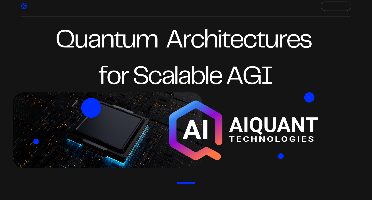
Udai Solanki
Project OwnerAI, Blockchain and Quantum Computing Researcher and Project Coordinator
DEEP Connects Bold Ideas to Real World Change and build a better future together.
Coming Soon
AIQUANT Technologies proposes a thorough assessment of quantum computing architectures which include: trapped-ion, superconducting, photonic, topological considering their relevance towards Artificial General Intelligence (AGI) systems, focusing on the OpenCog Hyperon framework. Our strategy entails theoretical work, hybrid quantum-classical simulations, and formal integration design work with the Hyperon team, distinguishing what is plausible from what is wishful thinking. In this case, we intend to provide quantum technologies insights regarding their feasibility, scalability, and integration augmented with AGI centered projects.
This RFP seeks a technical and experimental assessment of quantum computing architectures in AGI applications. Proposals should explore the practicality and limitations of various quantum approaches — including trapped-ion, superconducting, photonic, and topological quantum computing — in handling probabilistic reasoning, parallel processing, and large-scale knowledge representation. The research could include quantum-classical hybrid simulations and feasibility studies for applying quantum advancements to AGI workloads. Bids are expected to range from $20,000 - $100,000.
Analyze developments in trapped-ion and superconducting qubit research from the past five years through the lens of DiVincenzo’s criteria: scalability coherence gate universality and measurement fidelity in a comprehensive literature review.
Literature Digest (15 pp) synthesizing key performance data. Comparison Matrix of metrics (error rates gate speeds and coherence times).
$5,000 USD
Top-performing documented vendors with >99% single-qubit fidelity are ionQ and IBM Q. Rationale for prioritization is accepted by the technical leads from SingularityNET implementing primary drivers.
execute two quantum-classical hybrids: (a) inference of Markov Logic Networks via parameterized circuits (b) amplitude-encoded vector similarity on 10–16 qubits.
Project repository on GitHub containing Jupyter notebooks for the Simulation Codebase. 20-page document covering the latency resource consumption and noise-sensitivity of the СН replication detailing those profits for the Performance Report.
$7,000 USD
Complete the small-scale simulation tasks in under 2x the time of classical benchmarks computed classically. Identify threshold of noise associated with quantum supremacy computation advantage. Wikipedia.
redesign Hyperon’s knowledge-graph pipeline overseeing algorithmic steps defining quantum routine insertion sliced into APIs. Validate the designs by hosting a joint virtual workshop of ½ day design sessions ending with consensus on interface blueprints validation.
Illustrate data flow with UML Sequence Diagrams. Extend JSON-RPC Schema defining in detail the API Spec Sheet for programmable interface callable in machine-readable formats.
$7,000 USD
Stop workshop with Hyperon engineers for review of document endpoints. Perform a complete demonstration of a quantum call that has been stubbed within the Hyperon framework.
Integrate all relevant information into an executive briefing and pilot proposal with the goal of a 250000 dollar follow-on study detailing full QPU experiments and additional AGI benchmarking.
Executive Brief (12 pp) with discrete findings detailed cost-benefit analysis and stragetic recommendations. Deck for SingularityNET leadership consisting of 5 slides.
$6,000 USD
Leadership accepts proposal and consents to move forward with the pilot. At least two potential AGI use-cases identified for subsequent funding.
Reviews & Ratings
Please create account or login to write a review and rate.
Check back later by refreshing the page.
© 2025 Deep Funding
Join the Discussion (0)
Please create account or login to post comments.